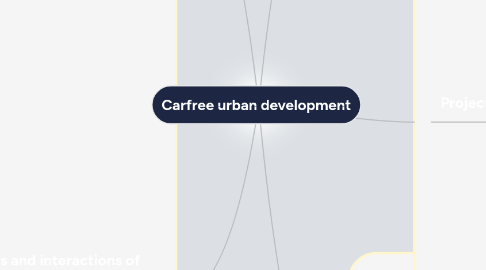
1. Customer demand
1.1. Sustainability
1.2. Being or becoming carfree
1.2.1. Lifestyle
1.2.2. Sectors of population
1.2.3. Psychological factors
1.2.4. Sociological factors
1.2.5. Car attachment / psychology of use
1.3. Life quality
1.4. Market study
1.4.1. Willingness to pay
1.4.2. Hedonistic studies
1.4.3. Stated choice
1.4.4. Survey
2. Decisions and interactions of key actors and stakeholders
2.1. Municipality
2.1.1. Strategical planning and policy
2.1.1.1. Parking policy
2.1.1.2. Holistic planning
2.1.1.3. Priorities
2.1.1.4. Objectives
2.1.1.5. Urban development policy
2.1.1.6. Environmental policy
2.1.1.7. Conditions and restrictions
2.1.2. Sub-actors
2.1.2.1. Politicans
2.1.2.2. Transport and parking department
2.1.2.3. Environmental department
2.1.2.4. Health department
2.1.2.5. Urban development department
2.1.2.6. General assembly
2.2. Community and NGO:s
2.3. Developer
2.3.1. Private
2.3.2. Public
2.3.3. Community organisation
2.4. Actor and decision study
2.4.1. Awareness (or lack thereof) of alternatives
2.4.2. Game theory (what's in it for me?)
2.4.3. Common interests
2.4.4. Conflicting interests
2.4.5. Perceived risk
2.4.6. Inertiia / willingness to change
2.4.7. Tradegy of the commons
3. Urban place planning
3.1. Walkabilty
3.1.1. Standard
3.1.2. Connectivity
3.1.3. Safety
3.2. Greenery
3.3. Social places
3.3.1. Children
3.3.2. Adults
3.3.3. Outdoor activities
3.3.4. Seating
3.4. Streetscape
3.5. Services nearby
3.5.1. Transport opportunities
3.5.2. Grocery stores
3.5.3. Shops
3.5.4. Cafés
4. Transport planning
4.1. Car
4.1.1. Speed
4.1.2. Barrier effect
4.1.3. Safety
4.1.4. Car-pooling
4.1.5. Attractiveness
4.2. Biking
4.2.1. Standard
4.2.2. Connectivity
4.3. Public transport
4.3.1. Location
4.3.2. Standard
4.3.3. Connectivity
4.4. Goods transport
4.5. Walking
4.6. Car parking
4.6.1. Parking building cost
4.6.2. Minimum parking requirements
4.6.3. User cost
4.6.4. Supply
5. Project development
5.1. Profitability
5.1.1. Costs
5.1.2. Incomes
5.1.3. Financing and funding
5.2. Marketing
5.2.1. Target groups
5.2.2. Quality of life
5.2.3. Children-friendly
5.2.4. Sustainabile
5.2.5. Noise-free
5.2.6. Clean air
5.3. Public engagement
5.4. Type of project
5.4.1. Lease or sell
5.4.2. Apartment types
5.4.3. Apartment standard
5.4.4. Pricing
5.5. Location choice
5.5.1. Centrality
5.5.2. Shops and services
5.5.3. Public transport standard
5.5.4. Mobility opportuinities
5.5.5. Modal share / relative attractiveness of different transport options
5.5.6. Urban density and compactness
5.5.7. Connectivity
